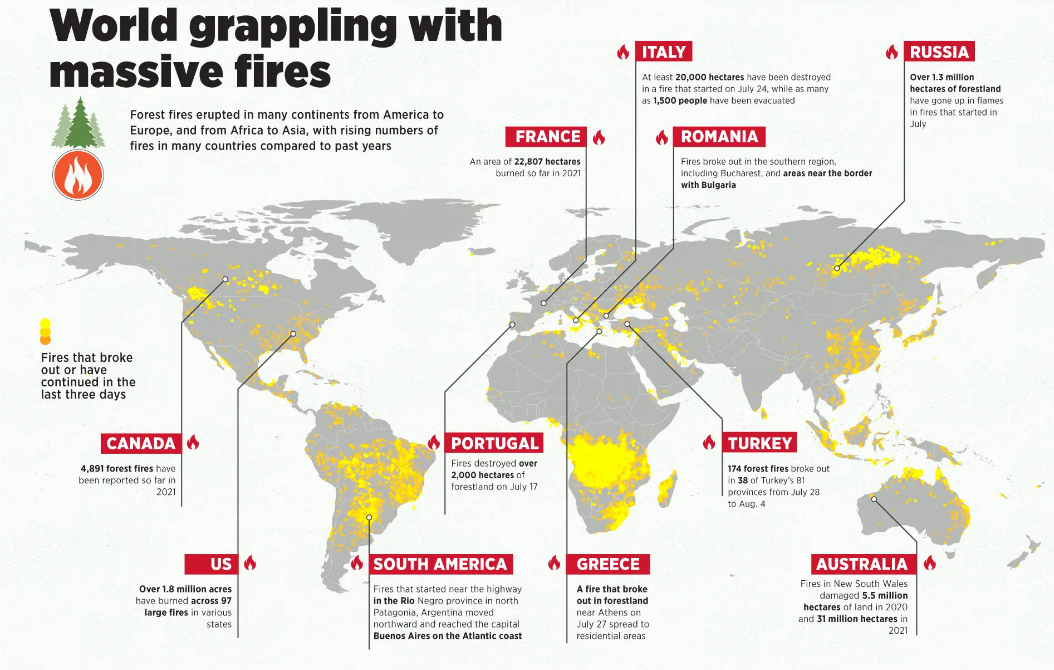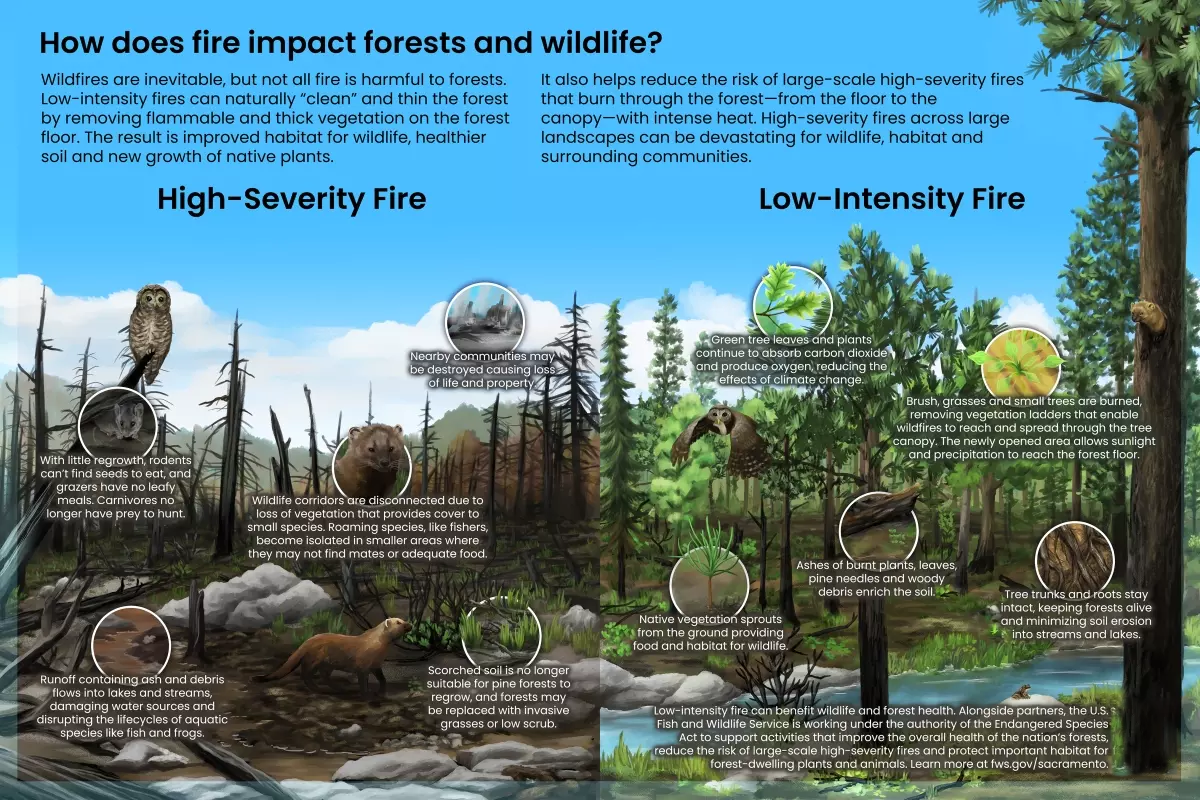Carbon Dioxide Emissions From Forest Fires | 24 Oct 2024
For Prelims: Extratropical and Tropical, Pyromes, Climate Change Effects, Carbon Emissions, Greenhouse Gases, Carbon Market, Carbon Credits, CO2.
For Mains: Impact of Forest Fires on Climate Change, Regional Variations in Fire Dynamics, Policy Implications for Fire Management, Role of Human Activities in Forest Fires
Why in News?
Recently, a study by the Centre for Wildfire Research has found that global CO2 emissions from forest fires have surged by 60% since 2001.
- Emissions from boreal forests in Eurasia and North America have nearly tripled, with climate change being identified as a major driver behind this increase.
What is Forest Fire?
- About:
- A wildfire, also known as a bushfire or vegetation fire, refers to any uncontrolled and non-prescribed burning of plants in natural environments such as forests, grasslands, or tundras.
- These fires spread based on environmental factors like wind and topography and consume natural fuels. For a wildfire to sustain combustion, three essential elements are required: fuel (plant material), oxygen, and a heat source.
- Classification:
- Surface Fire: Burns along the ground, consuming dry grasses, leaves, and twigs on the forest floor.
- Underground/Zombie Fire: Low-intensity fires burning beneath the forest floor, affecting organic matter.
- Canopy/Crown Fire: Spreads through the tree canopy, driven by wind and dry conditions, often intense and hard to control.
- Controlled Deliberate Fires: Prescribed burns by forest agencies to reduce fuel loads, lower wildfire risks, and maintain ecosystem health.
What are the Key Findings of the Study?
- Pyromes and Global Fire Patterns: The study uses machine learning to group global forest ecoregions into 12 distinct "pyromes," zones where forest fires exhibit similar patterns influenced by climate, vegetation, and human activities.
- Grouping these regions aids in understanding fire behavior and predicting the effects of climate change or land use, supporting better fire management and risk assessment.
- Geographical Shift in Fire Emissions: The analysis also revealed that apart from tropical and subtropical forest areas, extratropical forest fire carbon emissions from areas located outside the tropics have increased significantly due to climate change.
- Fire Severity and Carbon Combustion: Globally, the carbon combustion rate in forest fires has risen by 47%, with forests now contributing more to fire emissions than savannahs and grasslands.
- Increased fire severity is indicated by more fuel being consumed per unit of burned forest area.
- Climate Change and Fire Weather: Anthropogenic climate change is driving more frequent and severe droughts, creating "fire weather" conditions, characterized by low fuel moisture and dry, flammable vegetation.
- Increased lightning frequency, especially in high-altitude regions, is also contributing to the rise in forest fires.
- Forest Carbon Stock Destabilization: Carbon stocks in multiple forest types including temperate coniferous forests, boreal forests, Mediterranean forests, and subtropical dry and moist broadleaf forests, are destabilizing due to increased fire severity.
- Impact on Carbon Accounting: The rise in carbon emissions from forest fires presents challenges to carbon accounting and greenhouse gas (GHG) inventories submitted to the United Nations.
- For example, Canada’s 2023 wildfires are thought to have offset much of the carbon sink accumulated in its forests over the previous decade.
Carbon Capture and Storage (CCS)
- It is a process designed to mitigate the emissions of carbon dioxide (CO2) generated from industrial processes and the burning of fossil fuels, particularly in power plants.
- The goal of CCS is to prevent a significant amount of CO2 from entering the atmosphere and contributing to global warming and climate change.
What Are the Challenges Related to Forest Fires?
- Environmental Impact: Forest fires cause massive loss of biodiversity, damage ecosystems, and release large amounts of carbon dioxide, contributing to climate change.
- Fires emit harmful pollutants like particulate matter and greenhouse gases, affecting air quality and causing respiratory issues.
- Soil Degradation: High-intensity fires destroy nutrients in the soil, reducing fertility and disrupting ecosystems.
- Resource Loss: Forests provide essential resources like timber, food, and livelihoods for local communities, which are endangered by fires.
- Difficult Management: The increasing frequency and intensity of fires, exacerbated by climate change, make effective management and control challenging.
- Human Health: Fires cause health problems for nearby communities due to air pollution and heat exposure, leading to increased healthcare burdens.
- Economic Loss: Forest fires result in significant economic losses, including costs for firefighting, property damage, and recovery efforts.
What are the Forest Fires Scenario in India?
- Forest Fire Season and Incidence:
- India's forest fire season extends from November to June, peaking in April-May.
- According to the Forest Survey of India (FSI), 35.47% of India's forests are fire-prone, with varying degrees of risk across regions.
- Most vulnerable areas include Northeast India, Odisha, Maharashtra, Jharkhand, Chhattisgarh, and Uttarakhand.
- Recent Incidents (2024):
- Uttarakhand reported 1,309 forest fires between January and June 2024, an increase from previous years.
- ISRO data shows rising fires since March 2024, impacting multiple regions, including Maharashtra, Gujarat, and Odisha.
- Government Initiatives:
- National Action Plan for Forest Fires (NAPFF): Launched in 2018 to engage forest communities and reduce fire occurrences.
- Forest Fire Prevention and Management Scheme (FPM): Initiated in 2017 to assist states in managing forest fires through technical and financial support.
FAO Fire Management Guidelines
- Integration of Knowledge:
- The guidelines stress the importance of integrating science and traditional knowledge from Indigenous Peoples and local knowledge holders.
- This approach enhances fire management decisions, helps in preventing wildfires, managing fire outbreaks, and restoring areas affected by severe burning.
- Gender inclusion and diverse fire management knowledge are also promoted.
Way Forward
- Management Strategies: Effective forest management is crucial, particularly in extratropical regions. Monitoring vegetation and prioritizing areas for intervention can help mitigate risks.
- Tropical Strategies: In tropical regions, reducing ignitions during extreme fire-prone weather and preventing further forest fragmentation are essential for protecting forests.
- Fire Management Shifts: In regions with heavy fire suppression history, adopting ecologically beneficial fire practices may prevent forests from turning into carbon sources.
- Need for Accurate Reporting: The study calls for better reporting of forest fire emissions to the United Nations, addressing the gaps in current carbon budget reports linked to human-induced climate change.
- Carbon Credits Risk: The increasing risk of fire disturbances must be factored into reafforestation and carbon credit schemes, especially in extratropical regions, to avoid overestimating carbon storage potential.
Read More: FAO Guidelines on Wildfire Management
|
Drishti Mains Question What are the implications of increasing global forest fire emissions on climate change, and how should policies be adjusted to mitigate these risks? |
UPSC Civil Services Examination Previous Year Question (PYQ)
Prelims
Q. Consider the following: (2019)
- Carbon monoxide
- Methane
- Ozone
- Sulphur dioxide
Which of the above are released into atmosphere due to the burning of crop/biomass residue?
(a) 1 and 2 only
(b) 2, 3 and 4 only
(c) 1 and 4 only
(d) 1, 2, 3 and 4
Ans: (d)


